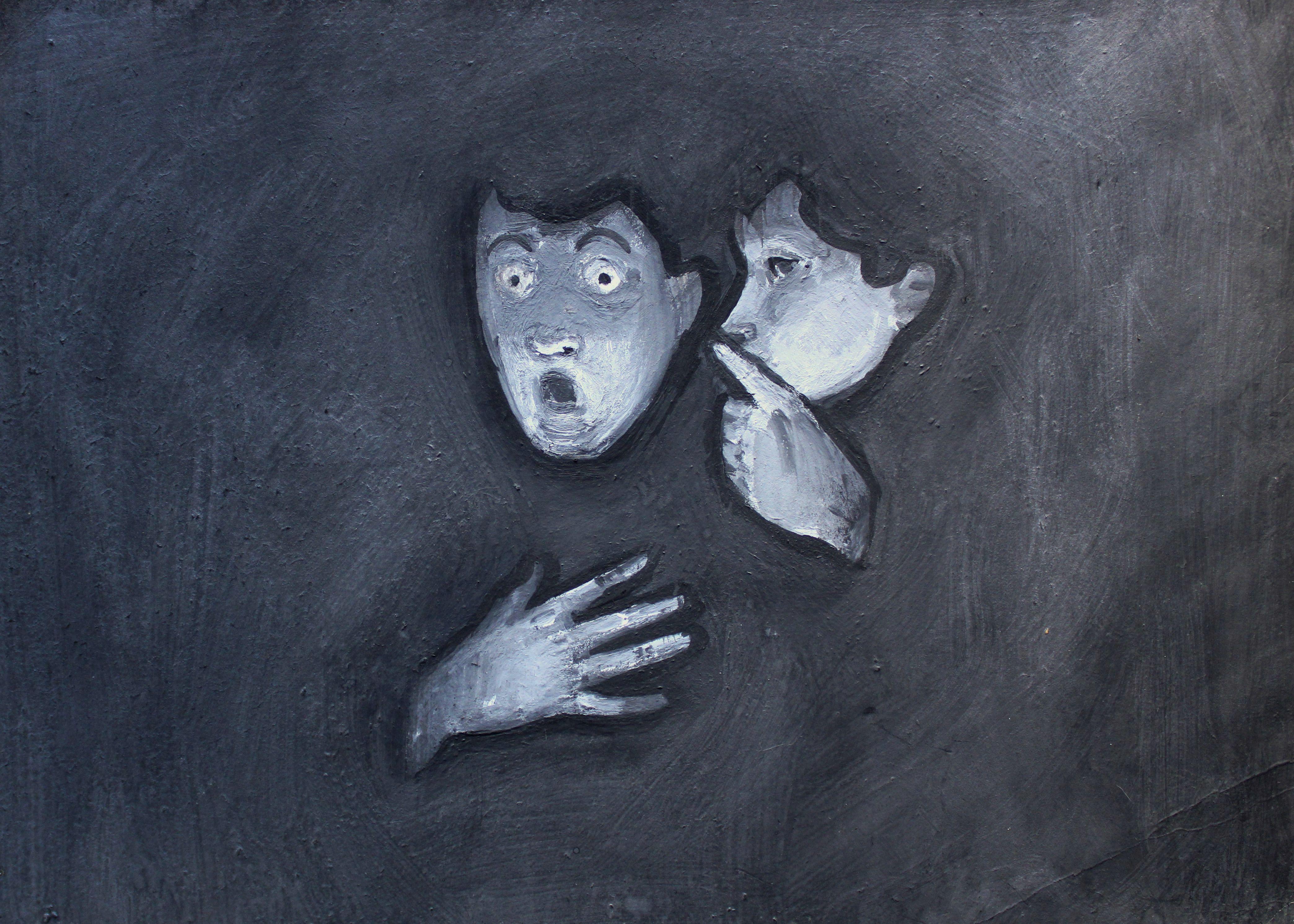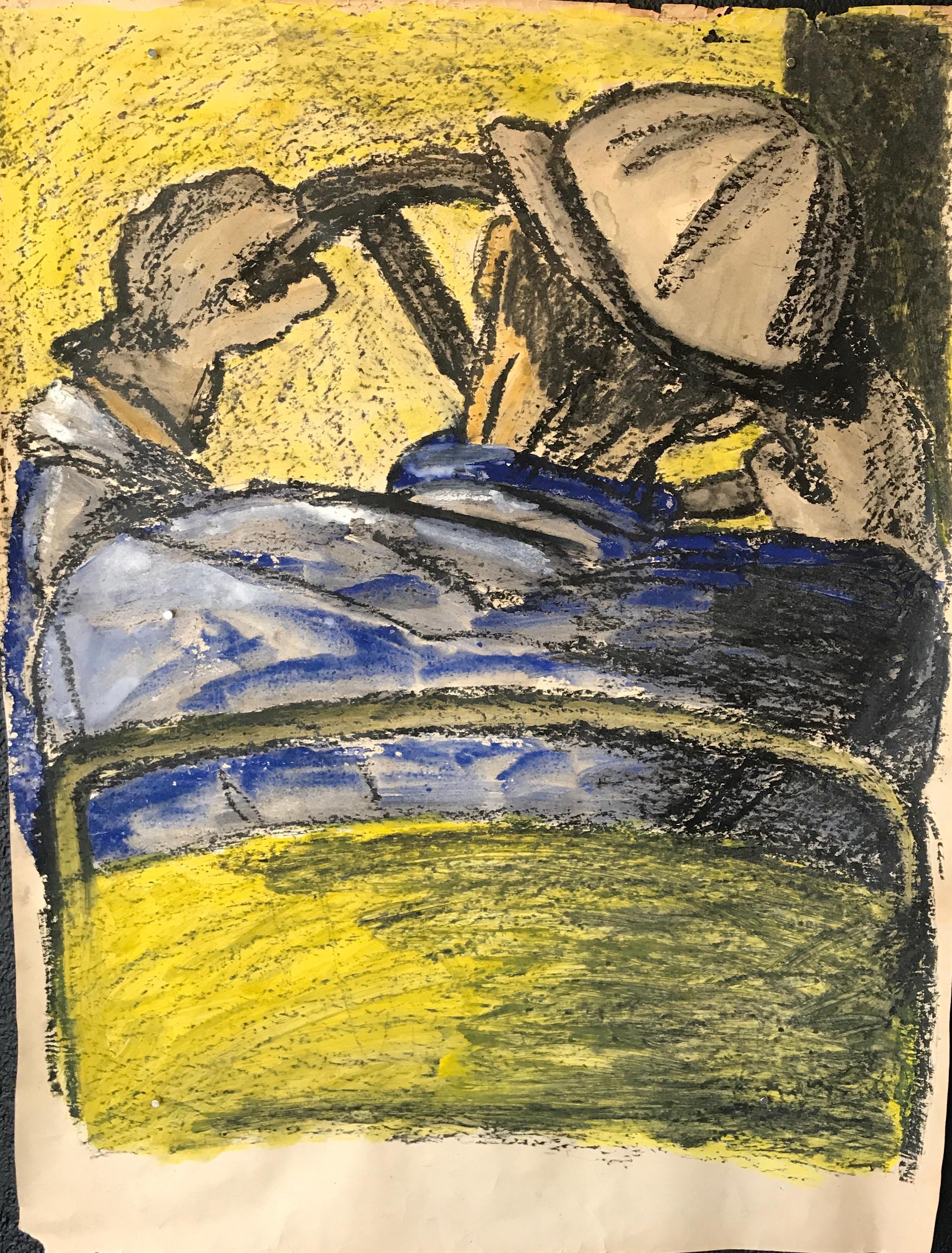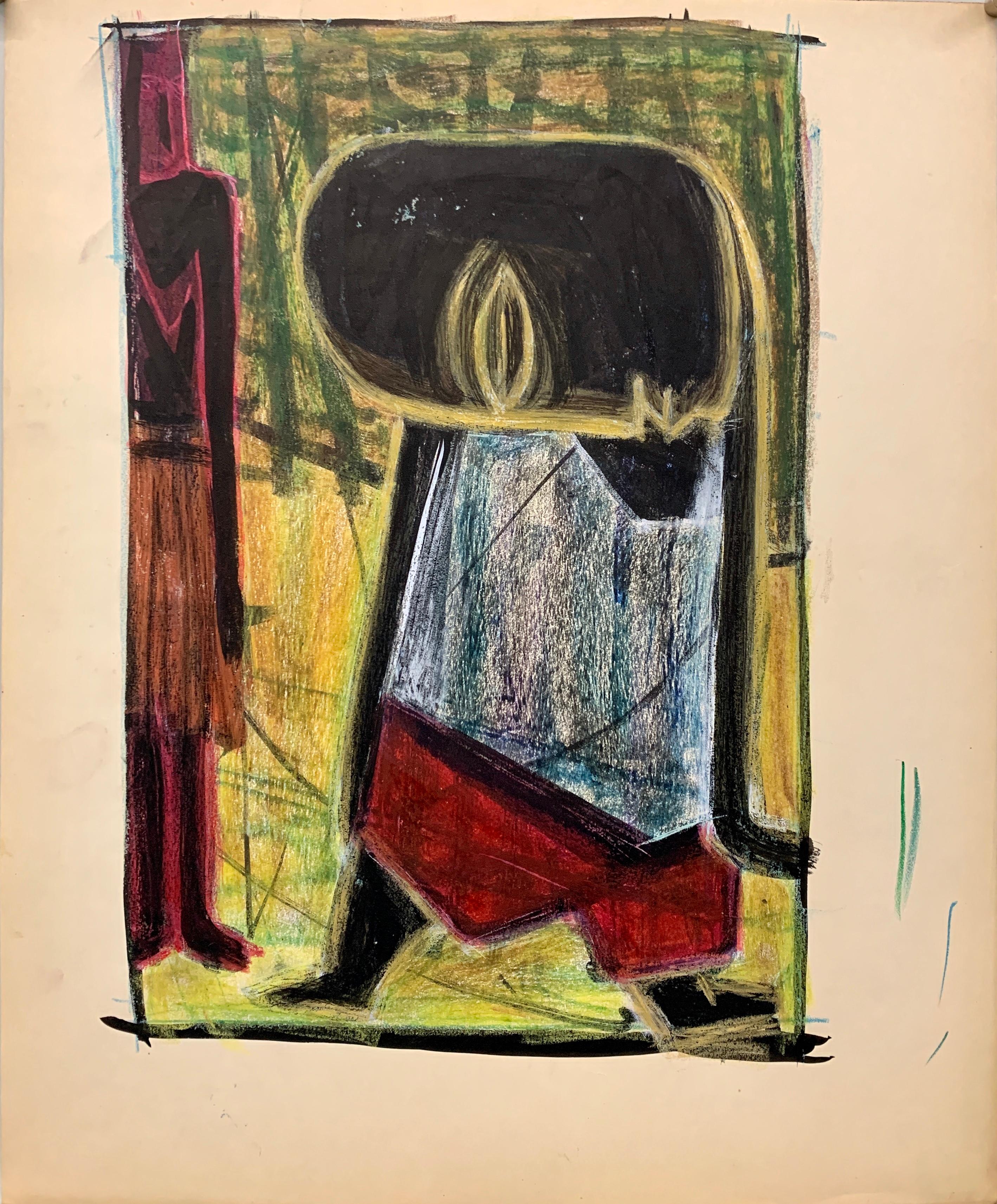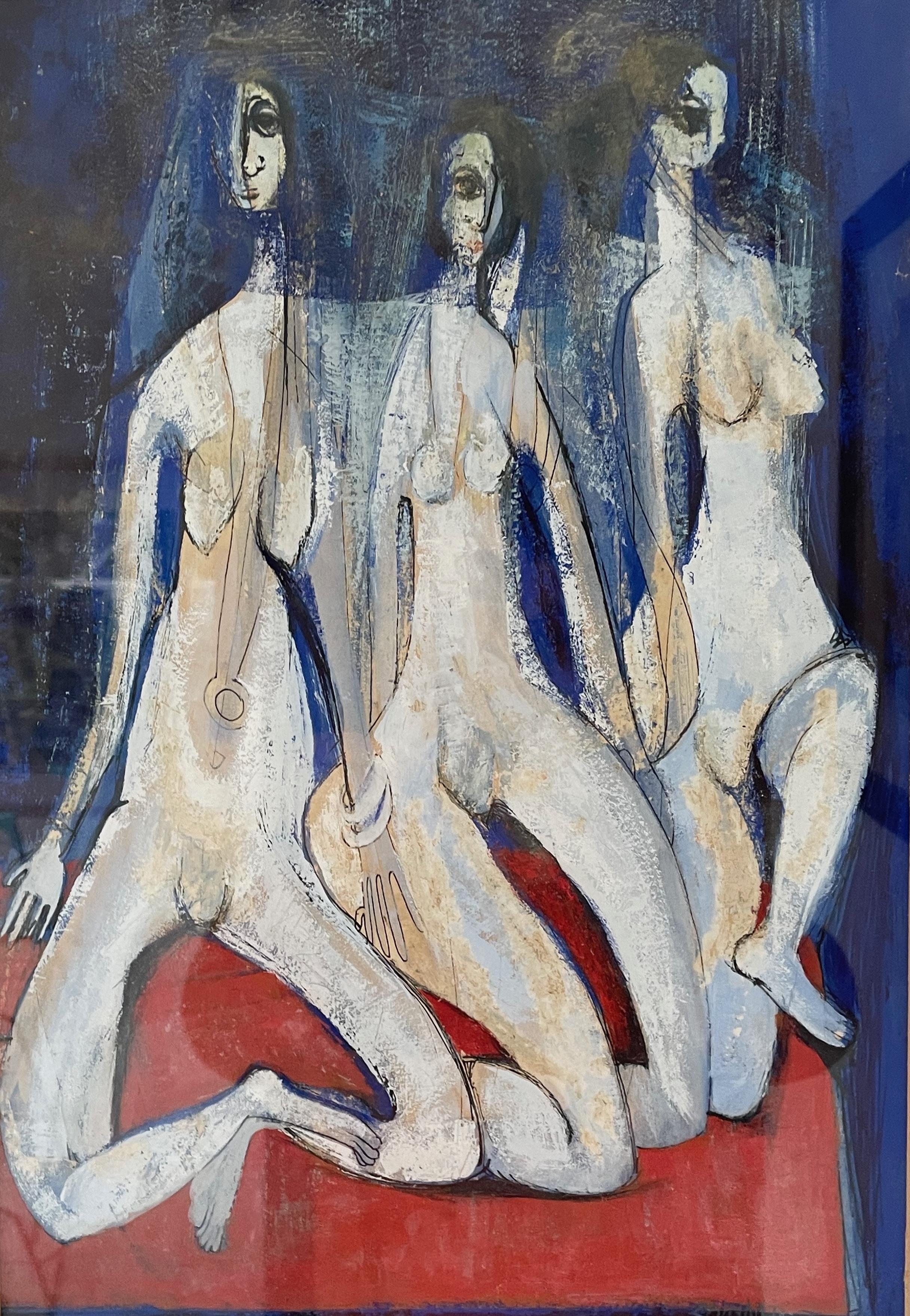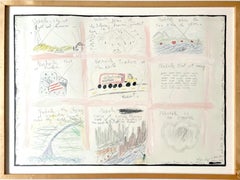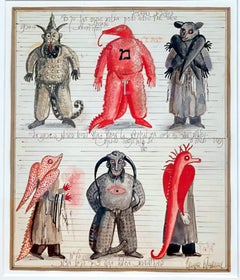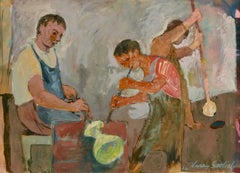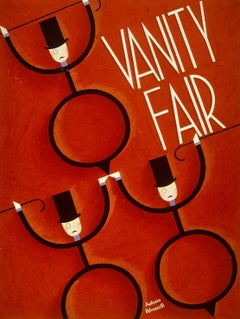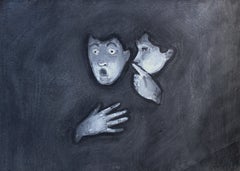Items Similar to Haitian Scene #7 Signed Mid Century modern painting, Associated American Artists
Want more images or videos?
Request additional images or videos from the seller
1 of 7
Adolf DehnHaitian Scene #7 Signed Mid Century modern painting, Associated American Artists1951
1951
About the Item
Adolf Arthur Dehn
Haitian Scene #7, ca. 1951
Watercolor gouache, hand signed; framed with AAA Gallery label verso
Signed on the front bearing the original label on the verso of Dehn's longtime gallery, the prestigious Associated American Artists Gallery, New York City.
Frame included: held in vintage frame with original label as provenance
Dehn, an influential artist and teacher (and author of the definitive textbook of his era on watercolor painting) joined Associated American Artists gallery in 1941. Although this painting is undated, it is likely circa early 1950s, as in 1951 Dehn won a Guggenheim Fellowship, which enabled him to travel to Haiti -- the subject of this work entitled "Haitian Scene #7". It was part of a series inspired by Dehn's visit to Haiti.
Framed, "Haitian Scene" measures 11.25 inches (horizontal) by 13.25 inches vertical.
Dehn, an influential artist and teacher (and author of the definitive textbook of his era on watercolor painting) joined Associated American Artists gallery in 1941. Although this painting is undated, it is likely circa early 1950s, as in 1951 Dehn won a Guggenheim Fellowship, which enabled him to travel to Haiti -- the subject of this work entitled "Haitian Scene #7". It was part of a series inspired by Dehn's visit to Haiti.
Framed, "Haitian Scene" measures 11.25 inches (horizontal) by 13.25 inches vertical.
ADOLF DEHN BIOGRAPHY
dolf Dehn was born in Waterville, Minnesota on November 22, 1895. As a young boy he began to sketch farm animals and by age nine dazzled the townsfolk attending the Waterville festival with a large drawing of a train. Being the "first artist of Waterville," he received a scholarship to the University of Minnesota, but against his parents' wishes he decided to attend the Minneapolis School of Art in the fall of 1914.
After volunteering for duty in an Asheville, North Carolina hospital during the First World War, he received an honorable discharge and in July 1919 Dehn took a train straight to New York. By 1920 he was studying under Boardman Robinson, who, along with Kenneth Hayes Miller, instructed Dehn in the rudiments of lithography. In 1921, Dehn's work was included as part of a group show of graphic design at New York's Weyhe Gallery. This was followed by a one man exhibition at Weyhe Gallery in 1923.
After this exhibition's success, Adolf Dehn decided to go to Europe to study art with an emphasis on lithography and printmaking. He worked almost entirely in black and white during the first two decades of his student and professional life. In Europe Dehn traveled extensively through Germany, France and England. Dehn eventually settled in Vienna in 1924, only to return to the United States after the economic crash of 1929. The prints Dehn made in Europe between 1928 and 1932 were exhibited in several one man exhibits beginning in 1935, 1939 and 1940 at the Weyhe Gallery. For these exhibitions Dehn had over ninety prints from which to select, many of which are still considered among his greatest works. In these prints Dehn had dared to do things technically that no artist had done before with ink washes, crayon, scrubbing, scumbling, and razor blading. Half of the prints were satires, while the rest were park scenes and landscapes.
In 1930 Dehn established his studio in New York at 20 East 15th Street, which he kept until 1954. During this period Dehn focused on New York City subjects as he rediscovered the parks, waterfront, restaurants and Harlem jazz clubs with John Dos Passos, Yasuo Kuniyoshi and Reginald Marsh. As an artist of the Depression-age, Dehn was aided by his commercial art contributions to The New Yorker, Vogue, Ringmaster, and The New York Times.
In 1937 Adolf Dehn's career took an important turn. He discovered that he liked working in watercolor: its fluidity was suitable to either deliberate or spontaneous efforts. In the beginning Dehn was a little insecure about his brush-drawn landscapes and his colors, as he had only worked in black and white up to that point in his career. Dehn's fear quickly subsided, however, at the American Artists' Congress show of 1937 when one of his paintings was the only picture sold in the show.
In 1939 Adolf Dehn was awarded his first Guggenheim Fellowship. This grant gave him the opportunity to travel extensively throughout the United States and Mexico. During these trips he drew, painted and recorded the varied terrain and picturesque landscapes as subjects for his work. Dehn also used this fellowship money in 1940 to spend some time in Colorado Springs, where he proceeded to teach at the Colorado Springs Fine Arts Center for three years. Life magazine reproduced many of Dehn’s watercolors from his Guggenheim travels across America in their August 11, 1941 issue. In 1941 Dehn joined the Associated American Artists Gallery. During the 1940s Dehn was a frequent summer visitor to the artist colony in Woodstock, New York, and participated in activities and exhibitions of the Woodstock Artists Association.
In 1941 when America entered the war against Japan and Germany, Dehn was forty-six, too old to be a soldier. Seeking a way to help the Allied cause, Dehn created a series of paintings for the U.S. Navy depicting the training, patrol and warfare of the air arm of the Navy. Some of Dehn's watercolors for Standard Oil of New Jersey were also used to illustrate the necessity of oil during wartime. Immediately after the war Dehn embarked on a period of large-scale print making using old and new sketches to create 13 x 17 inch prints. As a result of this project Dehn began to paint scenes of Central Park and the New York waterfront again as he worked on ideas for his print project. In 1948 Dehn spent his first winter in Key West, Florida. This led to his agreeing to teach at the Norton Museum School in West Palm Beach, Florida in the winter of 1951. Both winters in Florida produced some Florida subject works.
Dehn's first instructional book, Watercolor Painting, was published in 1945, followed by How to Draw and Print Lithographs (1950) and Watercolor, Gouache and Casein Painting (1955). Dehn was commissioned to write these books as he was recognized as one of the masters of watercolor and lithography. He was awarded another Guggenheim Fellowship in 1951 that granted him the opportunity to travel to new places, such as Haiti, Cuba and the Caribbean. Dehn added the Yucatan and Guatemala to his travels in 1955. Dehn's watercolors, shown at Milch Gallery in New York in 1957, attracted commissions from corporations which also sent him on assignments in the US and abroad.
In 1961, at the age of 65, Dehn's success was recognized by the National Academy of Design and he was made an Academician in honor of his forty years of significant achievements. In 1965 Dehn was elected to membership in the National Institute of Arts and Letters.
Adolf Dehn died of a heart attack in New York City on May 19, 1968. The Columbus Gallery of Fine Arts, Columbus, Ohio held a major memorial exhibition organized by the museum's director and Dehn's good friend, Mahonri Sharp Young. Between 1969 and 1970 the exhibition traveled to six other museums: The Butler Institute of American Art, Amon Carter Museum, Colorado Springs Fine Art Center, Wichita Art Museum, the Kansas Museum, and Springfield Museum.
In the 1980s a traveling exhibition of Dehn's work was held at the Hunter Museum of Art, Roanoke Museum of Fine Arts, Canton Art Institute, Midwestern Museum of American Art, the Sheldon Swope Art Gallery, and the Lakeview Museum of Art.
- Creator:Adolf Dehn (1895 - 1968, American)
- Creation Year:1951
- Dimensions:Height: 13.25 in (33.66 cm)Width: 11.25 in (28.58 cm)Depth: 0.5 in (1.27 cm)
- Medium:
- Movement & Style:
- Period:
- Condition:Good vintage condition with no apparent issues; held in original vintage frame with label from the renowned gallery Associated American Arts. Ships in the original frame to preserve provenance (frame is vintage).
- Gallery Location:New York, NY
- Reference Number:1stDibs: LU1745214700672
About the Seller
5.0
Platinum Seller
Premium sellers with a 4.7+ rating and 24-hour response times
Established in 2007
1stDibs seller since 2022
429 sales on 1stDibs
Typical response time: 2 hours
- ShippingRetrieving quote...Shipping from: New York, NY
- Return Policy
Authenticity Guarantee
In the unlikely event there’s an issue with an item’s authenticity, contact us within 1 year for a full refund. DetailsMoney-Back Guarantee
If your item is not as described, is damaged in transit, or does not arrive, contact us within 7 days for a full refund. Details24-Hour Cancellation
You have a 24-hour grace period in which to reconsider your purchase, with no questions asked.Vetted Professional Sellers
Our world-class sellers must adhere to strict standards for service and quality, maintaining the integrity of our listings.Price-Match Guarantee
If you find that a seller listed the same item for a lower price elsewhere, we’ll match it.Trusted Global Delivery
Our best-in-class carrier network provides specialized shipping options worldwide, including custom delivery.More From This Seller
View AllGerman Lesson (two separate unique watercolor gouaches, each hand signed) Framed
Located in New York, NY
Roberta Allen
German Lesson, 1981
Two separate mixed media works framed together: watercolor, gouache, ink, wash, laid paper collage (each signed by hand)
Signed twice: each of the s...
Category
1980s Contemporary Mixed Media
Materials
Ink, Mixed Media, Watercolor, Gouache, Pencil
Nashville is an Enigma, mixed media painting by renowned female artist, signed
By Katherine Porter
Located in New York, NY
Katherine Porter
Country Music (Nashville is an Enigma), 1986
Mixed media; colored pencil, gouache, and graphite on paper, uniquely signed and inscribed with Nashville dateline
Hand ...
Category
1980s Abstract Abstract Drawings and Watercolors
Materials
Mixed Media, Gouache, Color Pencil, Graphite
Adolf Dehn, Haitian Scene A, signed painting, Associated American Artists, 1950s
By Adolf Arthur Dehn
Located in New York, NY
Adolf Arthur Dehn
Haitian Scene A, ca. 1951
Watercolor gouache on board
Signed on the front
Frame included: held in vintage modern frame
Measurements:
Framed:
11 inches vertical by 13 inches horizontal by .75
Painting
4.5 inches by 6 inches
Watercolor gouache, hand signed; framed with AAA Gallery label verso
Signed on the front bearing the original label on the verso of Dehn's longtime gallery, the prestigious Associated American Artists Gallery, New York City.
Provenance
Associated American Artists
Frame included: held in vintage frame with original label as provenance
Dehn, an influential artist and teacher (and author of the definitive textbook of his era on watercolor painting) joined Associated American Artists gallery in 1941. Although this painting is undated, it is likely circa early 1950s, as in 1951 Dehn won a Guggenheim Fellowship, which enabled him to travel to Haiti -- the subject of this work. It was part of a series inspired by Dehn's visit to Haiti.
Dehn, an influential artist and teacher (and author of the definitive textbook of his era on watercolor painting) joined Associated American Artists gallery in 1941. Although this painting is undated, it is likely circa early 1950s, as in 1951 Dehn won a Guggenheim Fellowship, which enabled him to travel to Haiti.
ADLOF DEHN
Adolf Dehn, American Watercolorist and Printmaker, 1895-1968
Adolf Dehn was an artist who achieved extraordinary artistic heights, but in a very particular artistic sphere - not so much in oil painting as in watercolor and lithography. Long recognized as a master by serious print collectors, he is gradually gaining recognition as a notable and influential figure in the overall history of American art.
In the 19th century, with the invention of the rotary press, which made possible enormous print runs, and the development of the popular, mass-market magazines, newspaper and magazine illustration developed into an artistic realm of its own, often surprisingly divorced from the world of museums and art exhibitions, and today remains surprisingly overlooked by most art historians. Dehn in many regards was an outgrowth of this world, although in an unusual way, since as a young man he produced most of his illustrative work not for popular magazines, such as The Saturday Evening Post, but rather for radical journals, such as The Masses or The Liberator, or artistic "little magazines" such as The Dial. This background established the foundation of his outlook, and led later to his unique and distinctive contribution to American graphic art.
If there’s a distinctive quality to his work, it was his skill in introducing unusual tonal and textural effects into his work, particularly in printmaking but also in watercolor. Jackson Pollock seems to have been one of many notable artists who were influenced by his techniques.
Early Years, 1895 - 1922
For an artist largely remembered for scenes of Vienna and Paris, Adolf Dehn’s background was a surprising one. Born in Waterville, Minnesota, on November 22, 1895, Dehn was the descendent of farmers who had emigrated from Germany and homesteaded in the region, initially in a one-room log cabin with a dirt floor. Adolf’s father, Arthur Clark Dehn, was a hunter and trapper who took pride that he had no boss but himself, and who had little use for art. Indeed, during Adolf’s boyhood the walls of his bedroom and the space under his bed were filled with the pelts of mink, muskrats and skunks that his father had killed, skinned and stretched on drying boards. It was Adolf’s mother, Emilie Haas Dehn, a faithful member of the German Lutheran Evangelical Church, who encouraged his interest in art, which became apparent early in childhood. Both parents were ardent socialists, and supporters of Eugene Debs...
Category
1950s Modern Figurative Drawings and Watercolors
Materials
Watercolor, Gouache, Board
Study 8, Russian protest art Unique signed gouache & ink with provenance, Framed
By Grisha Bruskin
Located in New York, NY
Grisha Bruskin
Study 8, 1990
Ink and Gouache on paper
Hand signed and inscribed by the artist on the front
Original vintage frame with Marlborough Gallery label included
This work is...
Category
1990s Abstract Abstract Drawings and Watercolors
Materials
Ink, Gouache
Grisha BruskinStudy 8, Russian protest art Unique signed gouache & ink with provenance, Framed, 1990
$10,000 Sale Price
20% Off
Bathers
By Stanley Boxer
Located in New York, NY
Stanley Boxer
Bathers, 1967
Mixed Media watercolor & ink wash drawing
Hand signed by the artist on lower right hand corner on the front
8 1/2 × 11 1/4 inches
Unframed
This is a uniqu...
Category
1960s Abstract Expressionist Figurative Drawings and Watercolors
Materials
Ink, Mixed Media, Watercolor
Corpse Drawing #47, The Return of the Cadavre Exquis hand signed by four artists
Located in New York, NY
Francisco Fernández, Claudia Fernández, Diego Toledo, Hector Quinones
Corpse Drawing #47, The Return of the Cadavre Exquis, 1993
Ink, graphite, acrylic, and watercolor, with collage
...
Category
1990s Contemporary Figurative Drawings and Watercolors
Materials
Ink, Mixed Media, Acrylic, Watercolor, Graphite
You May Also Like
Glassblowers WPA American Scene Mid- 20th Century Modern Figurative Workers 1932
By Harry Gottlieb
Located in New York, NY
Glassblowers WPA American Scene Mid- 20th Century Modern Figurative Workers. Dated and signed "32 Harry Gottlieb" lower right. Sight: 13 1/8" H x 18 1/4" W.
Harry Gottlieb, painter, screenprinter, educator, and lithographer, was born in Bucharest, Rumania. He emigrated to America in 1907, and his family settled in Minneapolis. From 1915 to 1917, Gottlieb attended the Minneapolis Institute of Arts. After a short stint as an illustrator for the U.S. Navy, Gottlieb moved to New York City; he became a scenic and costume designer for Eugene O"Neill's Provincetown Theater Group. He also studied at the Philadelphia Academy of Fine Arts and the National Academy of Design.
He was one of America's first Social Realist painters, influenced by that Robert Henri-led movement in New York City where Gottlieb settled in 1918. He was also a pioneer in screen printing, which he learned while working for the WPA. He married Eugenie Gershoy, and the couple joined the artist colony at Woodstock, New York. He lectured widely on art education.
In 1923, Gottlieb settled in Woodstock, New York and in 1931, spent a a year abroad studying under a Guggenheim Fellowship.
In 1935, he joined the Federal Art Project...
Category
1930s American Modern Figurative Paintings
Materials
Paper, Gouache
Original Painting. Vanity Fair Illustration Proposal. Art Deco Modern 1930s
By Antonio Petruccelli
Located in New York, NY
Original Painting. Vanity Fair Illustration Proposal. Art Deco Modern 1930s
Antonio Petruccelli (1907 - 1994)
Vanity Fair
Illustration proposal, c 1930’s
18 X 13 3/4 inches (sight)
...
Category
1930s American Modern Figurative Paintings
Materials
Gouache, Board
Secret. 2023, gouache, paper, 12, 5 x 13 cm
Located in Riga, LV
Secret. 2023, gouache,, paper, 12,5 x 13 cm
Ansis Butnors (1977)
Education:
J. Rozentals Art School in Riga – 1989. – 1996.
Latvian Academy of Art, Painting Department – 1996. – 2...
Category
2010s Modern Figurative Paintings
Materials
Paper, Gouache
Secret. 2023., gouache, paper, 17. 5 x 24 cm
Located in Riga, LV
Secret. 2023., gouache, paper, 17. 5 x 24 cm
With defect, one corner has a bend.
Ansis Butnors (1977)
Education:
J. Rozentals Art School in Riga – 1989. – 1996.
Latvian Academy of...
Category
2010s Modern Figurative Paintings
Materials
Paper, Gouache
Market. 2022, paper, gouache, 25x25 cm
Located in Riga, LV
Market
2022, paper, gouache, 25x25 cm
Ansis Butnors (1977)
Education:
J. Rozentals Art School in Riga – 1989. – 1996.
Latvian Academy of Art, Painting Department – 1996. – 2000.
...
Category
2010s Modern Figurative Paintings
Materials
Paper, Gouache
1950s "Mark" Oil Pastel and Gouache Figurative Painting NYC Modern Mid Century
By Donald Stacy
Located in Arp, TX
Donald Stacy
"Mark"
c.1950s
Oil pastel and gouache paint on paper
14x17" unframed
Unsigned
Came from artist's estate
Donald Stacy (1925-2011) New Jersey
Studied: Newark School of ...
Category
Mid-20th Century Modern Figurative Paintings
Materials
Paper, Oil Pastel, Gouache
Recently Viewed
View AllMore Ways To Browse
7 Up Sign
Depression Modern
Modern American Street Scene
Horizontal Mid Century Art
Black And White Painting Mid Century Modern
Beach Scene Watercolor
Key West Artist
Vintage Hospital Signs
Restaurant Scene Paintings
Mid Century Painting French City Scene
Early 20th Century Winter Scenes
Old Farm Signs
Watercolor Winter Scenes
Mid Century French Street Scene
1940 Street Scenes
15th Century Oil Painting
Haiti Painting
Haitian Painting
